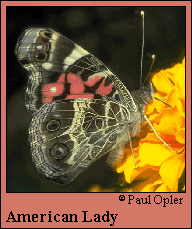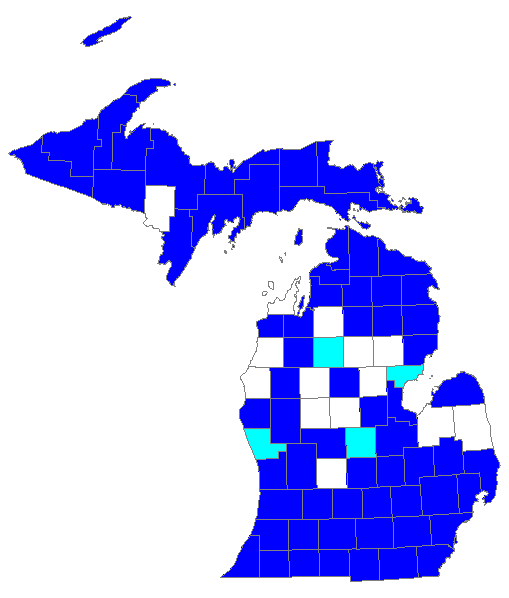 |
 

 |



American Lady (Vanessa virginiensis [Drury])
Wing span: 1 3/4 - 2 5/8 inches (4.5 - 6.7 cm).
Identification: Upperside with uneven brown, yellow, and orange pattern. Forewing with a black apical patch, a small white spot in the orange field below the patch, and a white bar at the leading edge of the forewing. Underside of hindwing with two large eyespots. Winter form is smaller and paler, summer form larger with brighter coloring.
Life history: During the afternoon, males perch on hilltops or on low vegetation if there are no hills. Females lay eggs singly on the top of host plant leaves. Caterpillars are solitary, living and feeding in a nest of leaves tied with silk. Adults hibernate.
Flight: Three to four broods from May-November, all year in the Deep South and South Texas. It is not known if adults can survive very cold winters; the East may have to be recolonized each year by southern migrants.
Caterpillar hosts: Plants in the sunflower family: sweet everlasting (Gnaphalium obtusifolium), pearly everlasting (Anaphalis margaritacea), plantain-leaved pussy toes (Antennaria plantaginifolia), wormwood (Artemisia), ironweed (Vernonia), and burdock (Arctium).
Adult food: Flower nectar almost exclusively, including dogbane, aster, goldenrod, marigold, selfheal, common milkweed, and vetch.
Habitat: Open places with low vegetation including dunes, meadows, parks, vacant lots, forest edges.
Range: Resident in the southern United States, Mexico, and Central America south to Colombia. Migrates to and temporarily colonizes the northern United States, southern Canada, the West Indies, and Europe. Rare stray to Newfoundland and Labrador.
Conservation: Not required.
The Nature Conservancy Global Rank: G5 - Demonstrably secure globally, though it may be quite rare in parts of its range, especially at the periphery.
Management needs: None reported.
References:
Opler, P. A. and G. O. Krizek. 1984. Butterflies east of the Great Plains. Johns
Hopkins University Press, Baltimore. 294 pages, 54 color plates.
Opler, P. A. and V. Malikul. 1992. A field guide to eastern butterflies. Peterson
field guide #4. Houghton-Mifflin Co., Boston. 396 pages, 48 color plates.
Scott, J. A. 1986. The butterflies of North America. Stanford University Press,
Stanford, Calif. 583 pages, 64 color plates.
Tilden, J. W. 1986. A field guide to western butterflies. Houghton-Mifflin Co.,
Boston, Mass. 370 pages, 23 color plates.
Author: Jane M. Struttmann
State and Regional References:
Layberry, R.A., Hall, P.W. & Lafontaine, D.J., 1998. The Butterflies of
Canada. University of Toronto Press, Toronto, ON. 280 pp.
Nielsen, Mogens C., 1999. Michigan Butterflies and Skippers: A Field Guide
and Reference. Michigan State University Extension, East Lansing, MI.
248 pp.
Opler, P.A. 1998. A field guide to eastern butterflies, revised format.
Houghton Mifflin Co., Boston.

